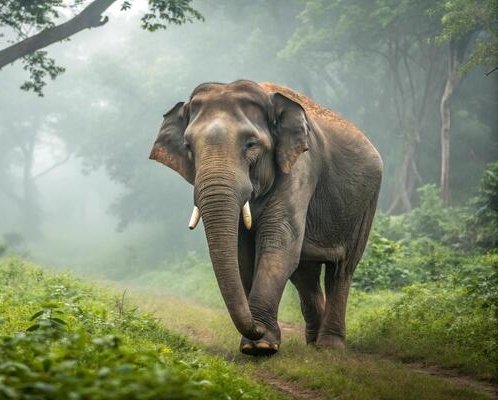Syllabus:
GS-3: Conservation, environmental pollution and degradation, environmental impact assessment
Context:
The All-India Synchronous Elephant Estimation (SAIEE) 2025 puts India’s elephant population between 18,255 and 26,645, with an average of 22,446.
More on the News
• The 2025 exercise, carried out jointly by the Environment Ministry, Project Elephant and the Wildlife Institute of India, establishes a new scientific baseline for future monitoring and conservation planning.
• The government released the long-delayed report nearly four years after the survey began in 2021.
Key Findings
• India’s wild elephant population has been estimated at 22,446, lower than the 2017 figure of 27,312, according to the country’s first-ever DNA-based count.
• Elephant population across regions:
- Western Ghats: 11,934
- North Eastern Hills and Brahmaputra floodplains: 6,559
- Shivalik Hills and Gangetic plains: 2,062
- Central India and Eastern Ghats: 1,891
• Elephant across various states:
- Karnataka: 6,013
- Assam: 4,159
- Tamil Nadu: 3,136
- Kerala: 2,785
- Uttarakhand: 1,792
- Odisha: 912
Methodology of SAIEEE 2025
• The latest exercise used a tiger-estimation-style method, dividing forested areas in 20 states into small blocks to record elephant signs, vegetation, other wildlife, and human activity.
• India’s forests were divided into 100 square km cells, further subdivided into 25 square km and 4 square km grids, which is a design borrowed from the tiger estimation program used since 2006.
• The new count used a three-phase process combining ground surveys, satellite-based mapping and genetic analysis.
- In the first phase, forest teams used the M-Stripes app to record elephant presence during extensive foot surveys.
- The second phase assessed habitat quality and human footprint using satellite data.
- The third phase involved DNA extraction from dung to identify 4,065 unique elephants, with scientists using the mark-recapture model to estimate the overall population.
• Using over 20,000 dung samples, scientists identified 4,065 unique elephants across major landscapes.
• Since elephants lack unique markings, DNA from dung helps researchers identify individuals and estimate population size.
Threats Across Elephant Habitats
• The report highlights significant threats to elephant habitats, including fragmentation caused by expanding coffee and tea plantations, invasive species, fencing, and rapid development in the Western Ghats.
• Habitat loss and corridor disruption are notable in the Western Ghats, Shivalik Hills, and Brahmaputra plains due to railways, roads, power projects, encroachments, and land-use changes.
• Mining is a major threat in Central India, alongside invasive plants, human disturbances, and conflicts with local communities, necessitating cooperative conservation efforts.
Sources:
The Hindu
Indian Express

